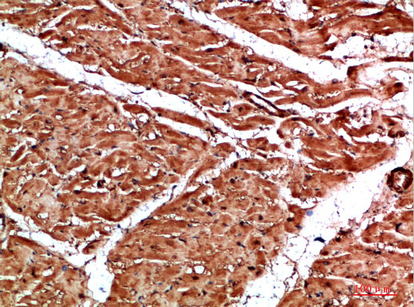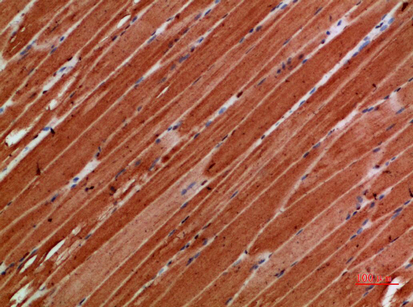TTN Polyclonal Antibody
- Catalog No.:YT6000
- Applications:IHC;IF;ELISA
- Reactivity:Human;Mouse;Rat
- Target:
- TTN
- Fields:
- >>Hypertrophic cardiomyopathy;>>Dilated cardiomyopathy
- Gene Name:
- TTN
- Protein Name:
- Titin (EC 2.7.11.1) (Connectin) (Rhabdomyosarcoma antigen MU-RMS-40.14)
- Human Gene Id:
- 7273
- Human Swiss Prot No:
- Q8WZ42
- Mouse Swiss Prot No:
- A2ASS6
- Immunogen:
- Synthetic peptide from human protein at AA range: 161-210
- Specificity:
- The antibody detects endogenous TTN
- Formulation:
- Liquid in PBS containing 50% glycerol, 0.5% BSA and 0.02% sodium azide.
- Source:
- Polyclonal, Rabbit,IgG
- Dilution:
- IHC 1:50-200, ELISA 1:10000-20000. IF 1:50-200
- Purification:
- The antibody was affinity-purified from rabbit antiserum by affinity-chromatography using epitope-specific immunogen.
- Concentration:
- 1 mg/ml
- Storage Stability:
- -15°C to -25°C/1 year(Do not lower than -25°C)
- Other Name:
- Titin (EC 2.7.11.1;Connectin;Rhabdomyosarcoma antigen MU-RMS-40.14)
- Background:
- This gene encodes a large abundant protein of striated muscle. The product of this gene is divided into two regions, a N-terminal I-band and a C-terminal A-band. The I-band, which is the elastic part of the molecule, contains two regions of tandem immunoglobulin domains on either side of a PEVK region that is rich in proline, glutamate, valine and lysine. The A-band, which is thought to act as a protein-ruler, contains a mixture of immunoglobulin and fibronectin repeats, and possesses kinase activity. An N-terminal Z-disc region and a C-terminal M-line region bind to the Z-line and M-line of the sarcomere, respectively, so that a single titin molecule spans half the length of a sarcomere. Titin also contains binding sites for muscle associated proteins so it serves as an adhesion template for the assembly of contractile machinery in muscle cells. It has also been identified as a structural protein for chromosomes.
- Function:
- alternative products:A number of isoforms may be produced, ranging from 27000 to 33000 residues in different striated muscle tissues, the size of the full length protein may be up to 38138 residues,catalytic activity:ATP + a protein = ADP + a phosphoprotein.,cofactor:Magnesium.,disease:Defects in TTN are the cause of cardiomyopathy dilated type 1G (CMD1G) [MIM:604145]. Dilated cardiomyopathy is a disorder characterized by ventricular dilation and impaired systolic function, resulting in congestive heart failure and arrhythmia. Patients are at risk of premature death.,disease:Defects in TTN are the cause of cardiomyopathy familial hypertrophic type 9 (CMH9) [MIM:188840]. Familial hypertrophic cardiomyopathy is a hereditary heart disorder characterized by ventricular hypertrophy, which is usually asymmetric and often involves the interventricular septum. The symptoms include dyspnea, synco
- Subcellular Location:
- Cytoplasm . Nucleus .
- Expression:
- Isoforms 3, 7 and 8 are expressed in cardiac muscle. Isoform 4 is expressed in vertebrate skeletal muscle. Isoform 6 is expressed in skeletal muscle (at protein level).
- June 19-2018
- WESTERN IMMUNOBLOTTING PROTOCOL
- June 19-2018
- IMMUNOHISTOCHEMISTRY-PARAFFIN PROTOCOL
- June 19-2018
- IMMUNOFLUORESCENCE PROTOCOL
- September 08-2020
- FLOW-CYTOMEYRT-PROTOCOL
- May 20-2022
- Cell-Based ELISA│解您多样本WB检测之困扰
- July 13-2018
- CELL-BASED-ELISA-PROTOCOL-FOR-ACETYL-PROTEIN
- July 13-2018
- CELL-BASED-ELISA-PROTOCOL-FOR-PHOSPHO-PROTEIN
- July 13-2018
- Antibody-FAQs
- Products Images

- Immunohistochemical analysis of paraffin-embedded human-heart, antibody was diluted at 1:200

- Immunohistochemical analysis of paraffin-embedded human-skeletal-muscle, antibody was diluted at 1:200



